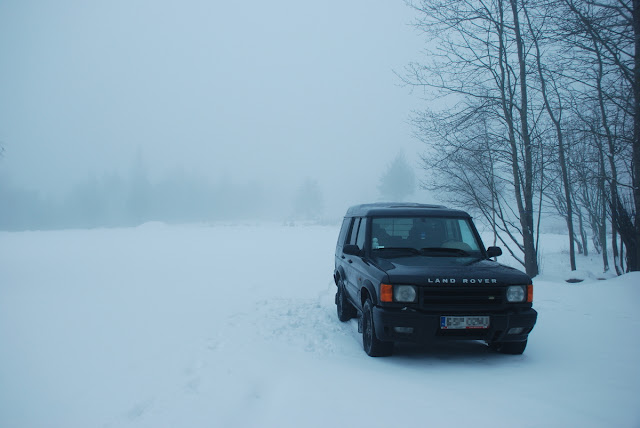Overhead Control Panel
In Discovery 2, the console above your head where sun roof controls are located, is an ideal place to add some custom controls and switches.Although there is a sun roof motor and control box plus ACE accelerometer hidden behind the console panel, there is still lots of space to fit some more stuff. All you have to do is to plan before you start drilling in the console, so there is enough space behind it to fit your equipment.
Here is what I ended up with in my Disco:
I added the the three lamps and the right switch first some time ago and used it for the roof halogens, therefore with the second (left) switch it looks not symmetrical, but this is what it is. If you plan all of your switches and indicators at once, you will place them much more ideally.
Items added to the console:
- A switch to enable/disable roof long range lights. The long range lights are put on simultaneously when the main beam is on, but with the overhead switch you can control if it is main beam+roof or just the main beam.
- A switch to enable/disable air compressor. When enabled, it will pump the air tank and keep the pressure as set in the pressure switch, in my case 6.5 bar.
- A red push button to honk the Siberian Express horns. The button originates from Polish tractor named Ursus where it served as a signal button.
- Three control lamps: green lights when roof long range lights are operating, yellow lights when air compressor is operating and red is not connected anywhere yet. The lamps are Linrose incandescent indicator lights and I bought them at Frys in the US.
- A manometer that presents current pressure in the air tank. I put a 6mm blue PE air pipe all the way from before the horn solenoid on the compressor side of the car (using a 3 way air splitter), through the engine compartment above the engine, through the grommet to under the fascia inside the car, up under the windshield pillar's cover and under the headlining to the space behind the panel. I made a solid half-loop with the pipe and plugged it into the manometer from the right side, so it had enough length to make panel removal comfortable. The manometer is a ICH 304.40.10 0-10 BAR, fi40 mm, G 1/8.
All the wirings at the back of the panel were soldered to a connector, to make the unmounting of the console as easy as possible.
The ignitition-switched +12V can be easily obtained from a Homelink cable, which in case of European models is not connected anywhere. It is a two-cable and two-pin loose connector, very easy to spot. The ground can be taken from there too, or from the interior lamp metal housing inside the console.
And some pictures of the console mounted in place:
Electrical Wiring
Here is a diagram of electrical connections for the roof long range lights, air compressor and horns. There are six boxes that represent different physical areas in the car, that are connected using extra wiring that was added for that purpose. The colors on the electrical lines between the boxes represent the colors of the wires that I used, so later I can figure out which wire serves which purpose.
- "Overhead panel" - the panel described above.
- "Under fascia" - the space under the steering wheel next to the fuse box. I used a 10-wire ribbon cable between this space and the Overhead Panel, putting it along the pillar and under the headlining. On both sides of the cable I used a Molex 12-pin connector kit.
- "Engine compartment" - the space next to the engine fuse box, originally intended for storing a jack. I put an auxiliary fuse box with fuses and relays in this space. Following cables were used to connect this space to other spaces:
- 4-wire 0.5mm2 electrical cable to "Under fascia"
- 2-wire 2.5mm2 speaker cable + 1 wire 0.5mm2 electrical cable in one conduit to the Compressor
- 2-wire 2.5mm2 speaker cable to the roof long range lights
- 2-wire 0.5mm2 electrical cable to the horn solenoid
- "Roof halogens" - a mounting bar on the roof holding four long range lights (not really halogens)
- "Compressor" - a space in a right side of a rear bumper holding the air compressor with the air tank
- "Horns" - a space under the chassis floor underneath the driver's seat holding Wolo 847 horns with solenoid valve.
And some view of the jack storage space with auxiliary fuse box. The red box is a chip tuning of unknown origin added by a previous owner. It looks like a SpeedBox, but really hard to say 100%.






























